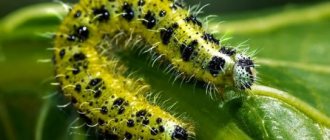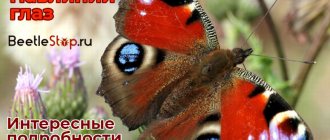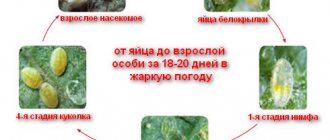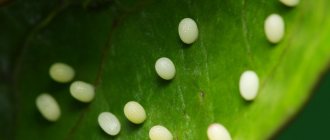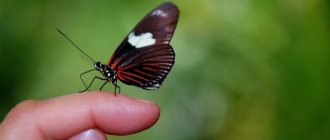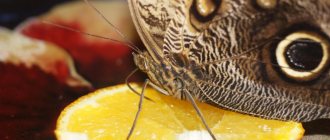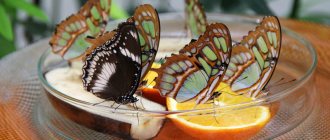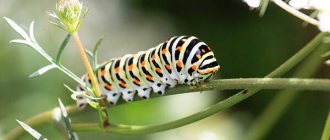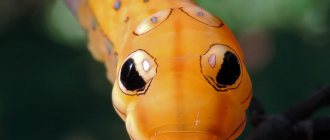Butterflies are a true miracle of nature. People call them fresh flowers and admire and adore them. How does the transformation from a caterpillar into a butterfly occur - stages of development.
Even small children know that a clumsy caterpillar turns into a gentle and graceful butterfly. But the details of the transformation process may surprise even adults.
Are caterpillars a separate species of insect?
Caterpillars are not representatives of a separate species, order or suborder of insects. This is one of the stages of development of butterflies - insects belonging to the order Lepidoptera.
A caterpillar is a butterfly larva that hatches from an egg and eventually develops into a pupa, from which a beautiful butterfly actually emerges.
Caterpillar
Until the caterpillar turns into a butterfly, the larva faces many dangers. Caterpillars use a variety of defenses to survive. Some are frightened by the bright colors, others by the unpleasant smell, and still others are completely poisonous.
Take advantage of these lessons
- Any trouble that happens to us makes us stronger. Learn to benefit from them.
- Our strength is in optimism. Use positive thinking and keep faith that things will get better.
- Don't give up, even if you really want to do it. Be purposeful and persistent.
- Any difficult circumstances can be analyzed and benefited from for subsequent personal growth.
- Don't focus on the bad. Remain in the thought that the darkest night is before the dawn.
- Get out of your comfort zone, remember that there are other horizons and next stages of development ahead. You are created for something more!
- Your mindset attracts certain events and people into your life. Positive thoughts lead to positive events. Your attitude towards life determines its level and points of development. All in your hands.
leave a comment
Stages of butterfly development
Butterflies are insects with a full cycle of transformation, that is, they go through all stages of development:
- egg;
- larva (caterpillar);
- chrysalis;
- imago (adult).
Each stage of the transformation of a caterpillar into a butterfly takes time and has its own characteristics.
Where do caterpillars come from and how do they grow?
After mating, the butterfly lays eggs. The number of eggs in a brood depends on the species to which the insect belongs. Some butterflies lay up to 1000 eggs.
But this does not mean that after a while 1000 larvae will be born. Butterfly eggs have many enemies among insects, and their development is greatly influenced by humidity and air temperature.
The eggs have a completely different shape. They can be oval, round, pear-shaped, flattened, cylindrical, cone-shaped.
The main color is light green, but there are also white, cream, blue, brown, red, yellow and other shades. Butterflies lay eggs singly or in groups.
The attitude towards future offspring varies greatly among different species of insects.
Some females scatter eggs everywhere, others attach them with a sticky secretion to a food plant so that the emerging larvae do not have to look for food, and still others lay them in a secluded place, covering them with their own hair.
The dense shell of the egg (chorion) protects the developing larva from mechanical stress and drying out. Inside the egg, in addition to the embryo, there is a supply of nutrients that ensure the growth and development of the future caterpillar.
The egg stage in most butterflies lasts from 1 to 3 weeks, but in some species it can last for months. The larva emerging from the egg looks like a tiny worm.
Its size, depending on the type, can vary from 1 to 5 mm. After the caterpillar hatches from the egg, it goes in search of food.
What a caterpillar eats is also determined by its species. This is mainly plant food: flowers, leaves, berries and fruits. Some people eat moss, mushrooms, horny substances, wax, and plant bark.
But there are also predators that eat aphids, worms and other caterpillars. Good nutrition is very important for the caterpillar, as it allows you to quickly gain weight and obtain enough material to form the cocoon of the future butterfly.
From caterpillar to chrysalis
As the caterpillar grows, it is released repeatedly. The average number of moults ranges from 4 to 7, but some species can mutate up to 40 times.
After each moult, the larva changes, and the changes affect not only the size, but also the color and even the structure of the body. In some types of transformations they are almost invisible, in others they are quite clearly manifested.
After the last moult, the caterpillar turns into a pupa. Shortly before the pupa, the larvae stop eating. Many begin to behave restlessly, constantly moving in search of the most suitable place.
Some species of caterpillars look for a secluded place to pupate, while others pupate openly. The process can occur on the ground, underground, on a leaf or on the stem of a plant.
The caterpillar larva forms a cocoon by releasing silk threads. The entire time the cocoon is being formed, the larva remains in one place, held firmly by its paws.
It is in the cocoon that the transformation of a caterpillar into a butterfly occurs.
From chrysalis to butterfly
While in chrysalis form, caterpillars are most vulnerable. They are motionless and cannot protect themselves from predators - birds and insects. The only thing that saves them is that the cocoon usually looks unpretentious and does not stand out much from the background of the environment.
Despite the fact that no movement is noticeable from the outside, many complex processes are taking place inside the cocoon at this time. The transformation of a larva into an adult (imago) in butterflies is called metamorphosis.
The final form of the insect is almost completely different from the intermediate form, that is, the larva. You can recognize the former caterpillar only by its paws.
In the case of butterflies, the caterpillar, once in the cocoon, secretes special substances, under the influence of which its body becomes liquid.
In this mass, imaginary discs are preserved, that is, groups of cells responsible for the formation of new tissues and organs of the future butterfly.
When the metamorphosis is completely completed, the insect secretes enzymes that devour the shell, after which the butterfly can emerge from the cocoon. First the head appears, then the torso and legs are compressed.
Immediately after the butterfly appears, it still cannot fly. His wings are wet and curled. The insect crawls higher and remains motionless until the wings expand, dry out and become strong.
Subsequently, the butterfly may make its first flight to find a mate for mating, then lay eggs and continue the butterfly lineage.
How long does the transformation take?
The time that passes from the moment the pupa is formed until the butterfly emerges varies greatly depending on the type of insect, climate zone and environmental conditions. In most cases, the revival process takes 2-3 weeks.
But in some species, the pupa takes much longer to transform into a butterfly. Some species overwinter as a pupa, while others spend several years in this state.
For example, in the fuzzy cocoon moth, the pupal stage can last up to 8 years. If external conditions are unfavorable, the butterfly is in no hurry to appear and waits.
It is difficult to predict what a butterfly will look like based on the appearance of a caterpillar. Sometimes the larva and adult insect are completely different, and in some cases the similarities are visible to the naked eye.
What happens during metamorphosis
Juvenile hormone delays metamorphosis at the larval stage. It works by blocking genes in imaginary discs—tiny disc-shaped sacs that are triggered when the caterpillar wraps itself into a chrysalis and turn into the butterfly's antenna, eye, wing or other element. Thus, the hormone is necessary for survival until metamorphosis.
As soon as the larva undergoes its final molt and metamorphosis begins, strange things happen to its body. Cells in the muscles, intestines and salivary glands are digested and serve as “spare parts” for the future butterfly. Every cell is programmed to destroy itself through the activation of enzymes called caspases.
Caspases are ruptured by a protein in cells, releasing the basic material to create butterflies. If not for the juvenile hormone, this could have happened at any time, killing the insect. Instead, nature programmed it to lower its level at the ideal moment for metamorphosis.
Once the caterpillar has expanded all its tissues except the imaginal discs, they use the protein-rich broth that surrounds them to stimulate the rapid cell division necessary to form the wings, antennae, legs, eyes, genitals and other elements found in an adult butterfly or moth. For example, an imaginary fruit fly wing disk may initially consist of 50 cells and increase to more than 50,000 cells by the end of metamorphosis.
Metamorphosis is more than just a stunning physical transformation. This is a clear demonstration of the evolutionary mechanism. Butterflies and caterpillars not only differ strikingly in appearance, but also behave differently. The caterpillar lives on a tree, and the butterfly flutters. The first eats leaves, and the second feeds exclusively on nectar.
Classification
There are different types of caterpillars. This is primarily due to the diversity of the Lepidoptera themselves. Interestingly, the color of the larva does not always match the color of the adult. One classification of caterpillar species is based on what they eat.
- The group of polyphages is represented by their representatives who are completely indiscriminate in food and can eat any plants. These include moths, for example, wine hawkmoth, ocellated hawkmoth, blind hawkmoth, kaya bear, moths, peacock eye and others.
- The group of monophages includes caterpillars that feed only on one specific type of plant. These are cabbageweed, apple moth, silkworm and some others.
- The group of oligophages includes those who feed on a specific type of plant; they represent one family or type. These include: swallowtails, pine cutworm, polyxena and others.
- Xylophages are caterpillars whose food is wood or bark. This group is represented by leaf rollers, wood borers and others.
Harmful relative
The large nocturnal peacock eye or pear peacock eye is active in the dark. There are external differences in both butterflies and caterpillars. This butterfly is a fairly large moth, with a wingspan of almost 15 and a half centimeters. Butterflies are distinguished by white, brown or black tints.
The caterpillars of these butterflies develop in June/August and are distinguished by a greenish tint, the body of which is quite large and covered with tubercles and processes of blue tones. The female lays her eggs on various fruit trees. Caterpillars, as a result of their gluttony, can cause serious damage to future harvests. This species of moth is also listed in the Red Book.
Females can live up to 20 days, but males die soon after mating.
Head.
On the head of the butterfly there are antennae, two large eyes and a proboscis. With their help, the insect receives all the necessary information about the surrounding world, which is extremely important for survival. The eye of a butterfly consists of thousands of elongated cells that create an overall picture. The antennae of butterflies are important sensory organs. They help balance during flight and recognize odors, and are used to detect flowers and fruits of plants, which are a rich source of nectar for butterflies.
The tubular proboscis is spirally curled at rest. When eating, the butterfly straightens its long proboscis, plunges it deep into the flower or fruit, and sucks out the nectar.
Necessary conditions of detention
Creating a homemade butterfly farm is a good gift for a child who will be able to watch the birth and formation of living creatures. A real tropical fairy tale unfolds before his eyes, because many types of butterflies have a colorful color.
In addition to a gift for a child, an insectarium (or, as it is also called, a “butterfly garden”) is an opportunity to build your own business by breeding these insects. Butterflies can be sold for holiday events, and the initial investment can pay off fairly quickly.
But the first thing you need to know is how to care for a butterfly at home? In order for them to feel comfortable, the humidity inside the insectarium must be maintained at 70-90% at a temperature of 24 to 26 degrees.
To tie the dolls you will need sticks (the distance between them is 15 cm). Maintaining distance is necessary so that nothing prevents butterflies from spreading their wings at birth.
